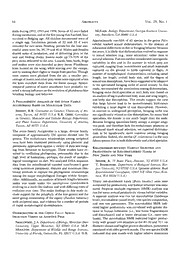
A phylogenetic analysis of the avian family Accipitridae based on molecular data PDF
Preview A phylogenetic analysis of the avian family Accipitridae based on molecular data
66 Abstracts VoL. 29, No. 1 mala during 1992, 1993 and 1994. Seven of 12 nests failed McLain. Biology Department, Georgia Southern Univer- during incubation, and ofthe five young that hatched, four sity, Statesboro, GA 30460 U.S.A. survived to fledging age. All clutches documented were of Approximately one-fifth of all species in the genus Falco a single egg. Incubation periods of 32 and 33 d were exhibit marked sexual dichromatism. In the absence of recorded for two nests. Nestling periods for the four suc- substantial differences in diet orforaging behavior between cessful nests were 36, 39, 39 and 40 d. Males and females the sexes, it is likely that dichromatism evolved in response shared tasks of incubation, and of delivering prey to the to sexual selection (e.g., mate attraction) rather than to nest and feeding chicks. Insects made up 73-95% of the natural selection. Falcons exhibitconsiderable interspecific prey items delivered to the nest. Lizards, bats, birds, frogs variability in diet and in the manner in which prey are and snakes were also recorded as prey items. Plumbeous captured, ranging from invertebrates and small mammals kites hunted on the wing, while soaring over the canopy, captured on the ground to birds captured in flight. A and by making short flights or stoops from perches. Though number of morphological characteristics, including tarsal most insects were plucked from the air, a smaller per- length, toe length, overall body size, and the degree of centage ofinsects and other prey items were captured when sexual size dimorphism, havebeen suggested to be adaptive the kites snatched them from the forest canopy. Spatio- to the specialized foraging niche of aerial avivory. In this temporal patterns of insect abundance have probably ex- study, we examined the associations among dichromatism, erted a strong influence on the evolution of plumbeous kite foraging niche (bird specialist or not), body size (based on breeding biology and behavior. an analysis oflog-transformed body mass and wing length), A Phylogenetic Analysis of the Avian Family and body size dimorphism. The results support the view that large falcons tend to be monochromatic bird-eaters Accipitridae Based on Molecular Data exhibiting a large degree of size dimorphism. However, SheeHY, R.R. Committee on Genetics, University ofAri- in contrast to widespread perception, foraging niche was zona, Tucson, AZ 85721 U.S.A. K.K. OlSHl. Committee not significantly related to size dimorphism; for many bird on Genetics, Molecular and Cellular Biology Department, specialists, the female is not much larger than the male. and Plant Sciences Department, University of Arizona, Because foraging specialists likely occupy a steeper adap- Tucson, AZ 85721 U.S.A. tive peak, and therefore lack the evolutionary plasticity to withstand much sexual selection, we expected dichroma- The avian family Accipitridae is a large, diverse family tism to be significantly more common among foraging composed of approximately 230 species divided into 56 genera. The evolutionary relationships among accipitrid generalists. Indeed, the merlin (F. columbarius) is the only falcon species that is both dichromatic and abird specialist. taxa have been examined previously using phenetic and parsimony approaches against a variety of data sets rang- Relationships between Habitat Selection and ing from behavior to karyotypic. These studies have re- Productivity of Red-shouldered Hawks in sulted in conflicting phylogenies, presumably due to the New Jersey and New York high level of homoplasy, perhaps, the result of morpho- logical convergence on diet. We analyzed DNA sequence Speiser, R. 13 Beam Place, Haledon, Nf 07508 U.S.A. data from the mitochondrial encoded cytochrome-b gene T. Bosakowski. Department ofBiological Sciences, Rut- using maximum parsimony, distance and maximum like- gers University, Nf 07102 U.S.A. (present address: Beak NE lihood methods to explore the phylogenetic relationships Environmental Consultants, 12931 126th Place, Kirk- among the major morphological lineages within Accipit- land, WA 98034 U.S.A.) ridae. Additionally, an analysis of branch lengths between Thirty red-shouldered hawk {Buteo lineatus) nests were nodes was made under the assumptions cytochrome-b monitored for productivity and habitat structure was mea- evolving in a clock-like fashion and with differing rates of sured. Stepwise multiple regression (SMR) analysis was evolution over time. The major findings in this study in- run for mean annual productivity versus habitat variables. clude support for the polyphyly of the kite genera and the A separate analysis was run for macrohabitat (landscape sister group relationship of the osprey {Pandion haltaetus) level), microhabitat (stand level), tree species composition, with accipitrid taxa, and evidence for a number of periods SMR and nest tree parameters. The macrohabitat indi- of rapid morphological diversification. cated higher productivity was correlated with greater dis- tance to human habitation (i.e., less forest fragmentation Dichromatism in the Genus Falco: Sexual and disturbance) and at lower elevations (i.e., more wet- Selection Versus an Adaptive Peak SMR lands). The microhabitat indicated higher produc- Smallwood, J.A. Department ofBiology, MontclairState tivity with greater tree densities in the 40-50 and 70+ cm University, Upper Montclair, Nf 07043 U.S.A. M.P. diameter classes and higher percent decadence, parameters SMR Moulton. Department of Wildlife and Range Sciences, associated with oldergrowth stands. Thetree species University ofFlorida, Gainesville, FL 32611 U.S.A. D.K. indicated that nest stands with higher relative dominance
